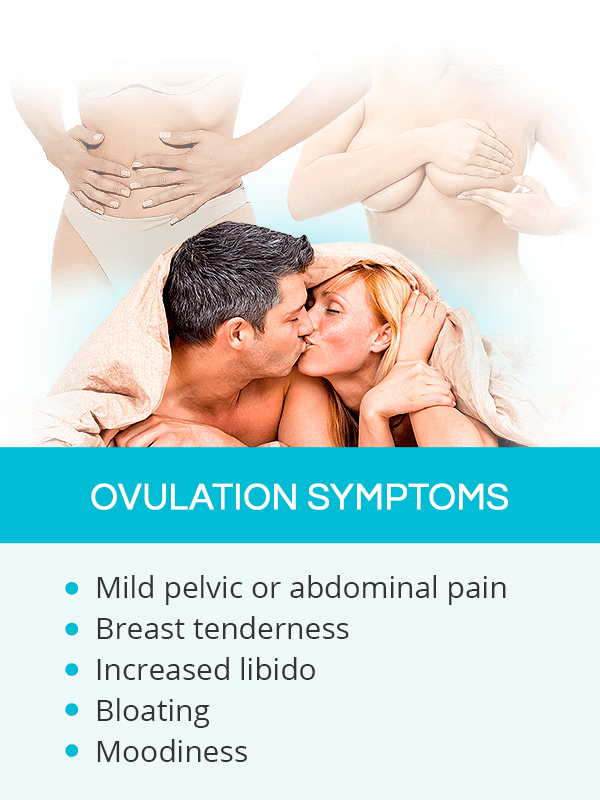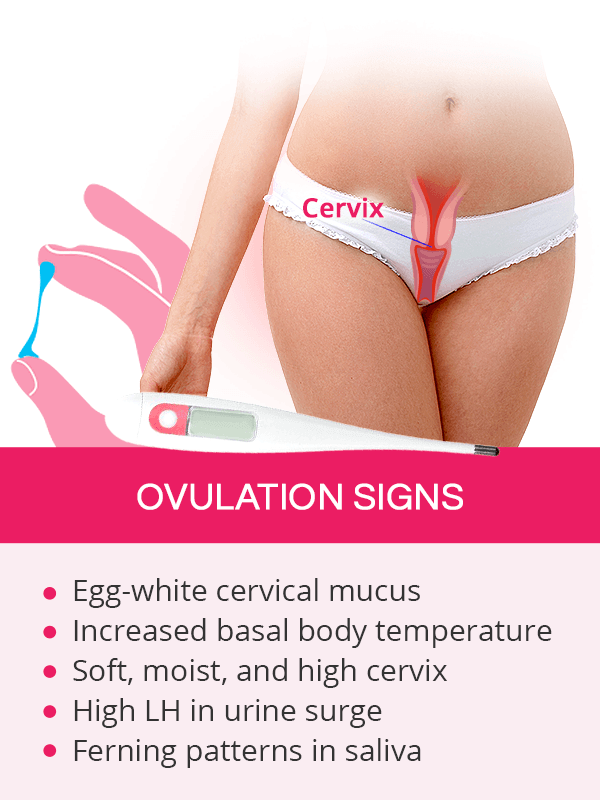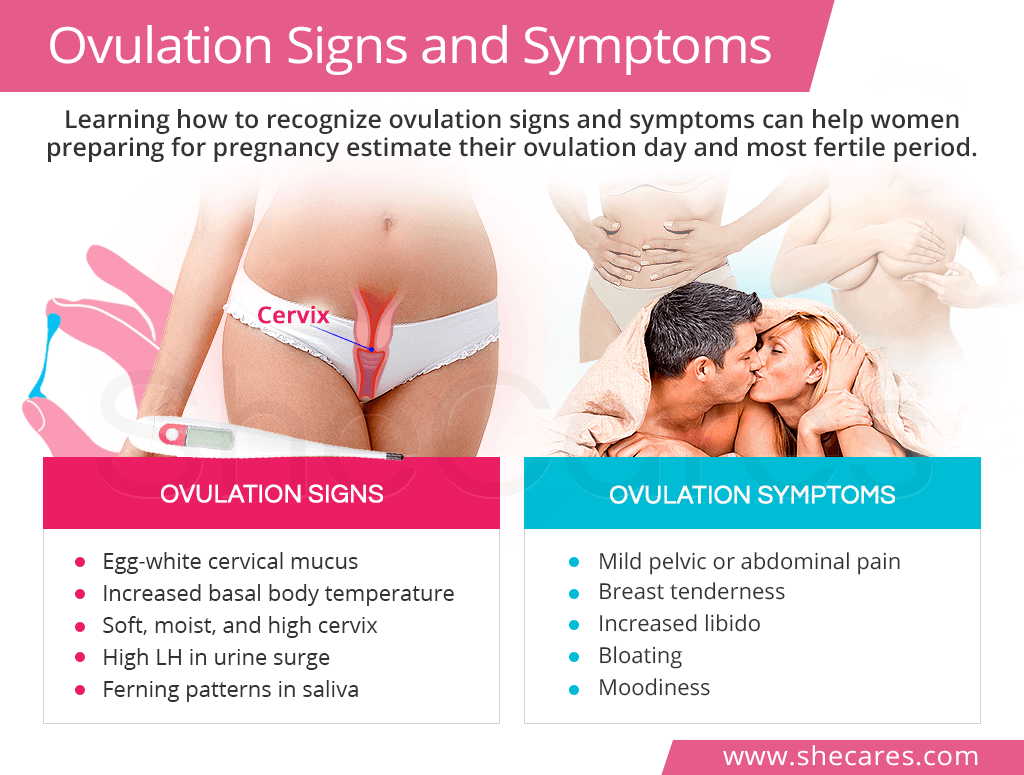Ovulation Symptoms

Many women do not experience any symptoms around their ovulation. Unlike premenstrual syndrome (PMS) or menopause, ovulation is not known to cause debilitating discomforts. As a result, the majority of women are not aware if they ovulate until they begin pre-pregnancy planning.
Three most common ovulation symptoms include:
Pelvic or abdominal pain
Ovulation pain is also called mittelschmerz, which is German for “middle pain.”
The pain is usually mild to moderate, and it can last from a few minutes to several hours. In rare cases, women experience it for a few days. It can be felt in the pelvis or lower abdomen right before or during ovulation, and it can be described as a dull, sharp and pulsing, or burning sensation.
Ovulation pain occurs on the side of the ovary that contains the dominant follicle that is being released during ovulation in a given month. It is most probably caused by the growing follicle before its rupture or a release of the fluid once the egg is released.
It is worth keeping in mind that if pelvic or abdominal pain persists past ovulation or becomes severe, another underlying cause, like endometriosis, ovarian cysts, or ectopic pregnancy, should be investigated.
Breast Tenderness
Upon the release of mature egg, breasts and nipples might become tender or sore. Also, the breasts may seem fuller and denser.
This type of cyclic breast pain is not serious and is caused by the fluctuation of estrogen and progesterone. It results in the expansion of milk ducts and the formation of milk glands, both of which cause the breasts to become more tender, painful, and swollen.
Because of those hormonal changes, ovulation breast tenderness in some women continues until menses, which usually comes two weeks later.
Increased Libido
Increasing estrogen levels leading up to an LH surge can boost female sex drive.
From a biological perspective, the concept behind ovulation is to prolong the species. So, increasing libido around this time heightens the chances for sexual intercourse, which can thus lead to conception.
Besides libido, there are other features in human sexuality that make sex more probable. Studies have shown that a woman's attractiveness is rated higher by men when she is ovulating, possibly due to her subconscious behavioral cues or pheromones. Women also report sex around ovulation more enjoyable, perhaps because of better vaginal lubrication and a higher positioned cervix.
Other Symptoms of Ovulation
Bloating around ovulation is caused by water retention resulting from an estrogen influx. Ovulation bloating usually lasts for a day or two, and it might be accompanied by digestive problems, such as diarrhea or constipation.
Moodiness, or mood swings, is caused by a disrupted production of the mood-improving neurotransmitter, serotonin, due to an ovulation-related estrogen and progesterone imbalance. Women might experience a sudden influx of contradictory emotions, such as anger, anxiety, joy, or laughter. Ovulation mood swings don't usually last long.
Ovulation bleeding or vaginal discharge might result from the rupture of the follicle once it releases the egg. Spotting between periods can also be a sign of pregnancy, approaching menopause, or other conditions, depending on the time it occurs.
Increased sense of smell as woman approach ovulation is an evolutionary feature that conditions females to be attracted to the pheromones androstenone and androsterone released by the opposite sex.
Ovulation Signs

For women who do not experience any clear symptoms, signs of ovulation can provide more reliable clues. These indicators can be measured and produce concrete parameters, unlike self-perceived symptoms that only women themselves can report.
There are three mains signs of fertility detectable around ovulation, which include:
Egg White Cervical Mucus
The consistency of the cervical mucus, or fluid, changes throughout the menstrual cycle according to natural hormonal fluctuations.
As a woman gets closer to her ovulation day, her body produces more estrogen, which, in turn, causes the mucus to become more clear and stretchy. It is often described as an egg white consistency. Cervical mucus during ovulation is also more abundant.
This egg white consistency also indicates that the cervical mucus is the most fertile. It is designed to facilitate the sperm's journey to the fallopian tubes to fertilize the egg. It is also the same ovulation mucus that is rich in nutrients to keep sperm alive for up to five days in the reproductive tract, increasing the chances of conception.
Checking cervical mucus through self-assessment is one of the best ovulation tests, which can help women be certain they are near ovulation.
Basal Body Temperature (BBT)
BBT temperature refers to the temperature of the body upon waking up. It remains fairly stable throughout the first part of the menstrual cycle, the follicular phase, and slightly elevated in the luteal phase following ovulation.
For about 24 hours from the moment ovulation begins, there is an increase in progesterone to prepare the uterine lining for possible implantation of fertilized egg. This, in turn, causes a slight rise in body temperature by 0.5 - 1°F, which is preceded by a small decrease a day before ovulation begins.
Being able to detect a slight BBT temperature decrease followed by an increase provides hints about the pattern of a woman's ovulation. The best time to have sex is as soon as that initial temperature drop is registered.
Measuring BBT is another reliable way of estimating approaching ovulation. In order to collect reliable data, BBT has to be recorded for several months with a special thermometer that is able to detect slight temperature changes.
Luteinizing Hormone (LH) Surge
LH is produced by the pituitary gland and remains very low throughout the menstrual cycle.
Roughly midway through an average cycle, the increasing estrogen causes a sharp increase in LH levels, called an LH surge. Those high levels of luteinizing hormone, peaking at 25 - 40 mlU/mL, are what trigger ovulation 24 to 36 hours later.
Measuring the LH levels in the saliva using ovulation test kits is a good way to know ovulation is approaching. However, it does not confirm that ovulation has, in fact, occurred.
Certain medical conditions can trigger a rise in LH without triggering the release of an egg, such as luteinized unruptured follicle syndrome (LUFS). Also, women with polycystic ovarian syndrome (PCOS) might experience small LH peaks before the major LH surge, causing confusion about when a woman's fertile window actually happens.
Other Ovulation Signs
Although less common, other signs of ovulation can also be used to confirm the approaching event. They include:
Cervical changes. Right before ovulation, the position of the cervix changes. It moves higher up into the body to make conception easier. It also becomes soft, open, and moist. It can be felt through self-examination or by a gynecologist.
Ferns are crystal-like patterns found in the samples of dried saliva. They form because of the influx of estrogen preceding the LH surge. They can be detected with ovulation microscopes
Key Takeaways
Symptoms and signs of ovulation are clear indications of approaching ovulation, marking a woman's fertile window. They are caused by hormonal fluctuations of key reproductive hormones, estrogen and progesterone. The most common ovulation symptoms include mild pelvic pain, breast tenderness, and increased libido; whereas, the signs of a woman's heightened fertility include having egg white consistency cervical mucus, high levels of LH, or changes in basal body temperature. Learning how to recognize these ovulation signs and symptoms can help women preparing for pregnancy detect their most fertile days to increase the likelihood of conceiving.
Sources
- American Pregnancy Association. (n.d.). Signs and Symptoms of Ovulation. Retrieved August 23, 2018 from http://americanpregnancy.org/getting-pregnant/signs-of-ovulation/
- Better Channel. (2018). Ovulation. Retrieved August 23, 2018 from https://www.betterhealth.vic.gov.au/health/conditionsandtreatments/ovulation
- Bioengineering & Translational Medicine. (2017). Detection of ovulation, a review of currently available methods. Retrieved August 23, 2018 from https://www.ncbi.nlm.nih.gov/pmc/articles/PMC5689497/
- Journal of Sex Research. (2004). Women's sexual experience during the menstrual cycle: identification of the sexual phase by noninvasive measurement of luteinizing hormone. Retrieved August 23, 2018 from https://www.ncbi.nlm.nih.gov/pubmed/15216427
- Medline Plus Medical Encyclopedia. (n.d.). Mittelschmerz. Retrieved August 23, 2018 from https://medlineplus.gov/ency/article/001503.htm
- Office on Women's Health. (2018). Trying to conceive. Retrieved August 23, 2018 from https://www.womenshealth.gov/pregnancy/you-get-pregnant/trying-conceive
- Physiology & Behavior. (2013). Greater overall olfactory performance, explicit wanting for high fat foods and lipid intake during the mid-luteal phase of the menstrual cycle. Retrieved August 23, 2018 from https://www.sciencedirect.com/science/article/abs/pii/S0031938413000371
- The BMJ. (2000). The timing of the “fertile window” in the menstrual cycle: day specific estimates from a prospective study. Retrieved August 23, 2018 from https://www.ncbi.nlm.nih.gov/pmc/articles/PMC27529/


